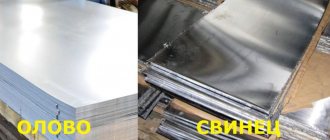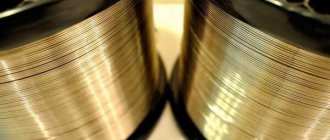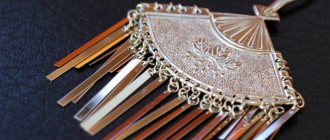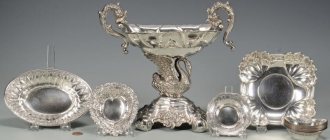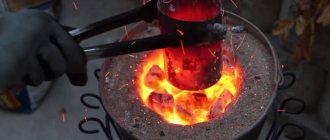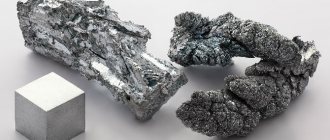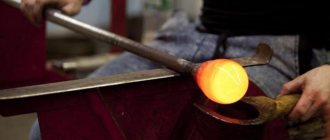When soldering heat-sensitive parts with conventional solders, they are destroyed by overheating. Rose alloy melts at low temperatures and allows you to attach small elements without touching them with a soldering iron. The absence of cadmium in the alloy makes it less toxic.
The alloy was named POSV-50. It is produced according to TU 6-09-4064-87 and is widely used by radio amateurs and in various industries. The low melting point is used in emergency devices that protect against overheating.
Alloy rose (Photo: Instagram / papamaster_msk)
brief information
The composition of the Rose alloy includes:
- bismuth 50%;
- lead 25%;
- tin 25%.
The permissible deviation of the proportions of the components is ±0.5%. In terms of physical parameters, this solder is close to Wood’s alloy, but has less toxic properties due to the absence of cadmium in its composition, therefore it is more suitable for home use. Its use does not require equipment with an exhaust hood at the workplace.
The melting point of the Rose alloy is +94 °C. It hardens already at +93 °C. This temperature regime is successfully used for tinning boards with Rose alloy. At home, this process can be carried out in boiling water. But it should be remembered that this alloy is sensitive to overheating, in addition, it is quite fragile.
Rose alloy, what is it and why is it called that? Solder is named after the famous German chemist Valentin Rose Sr. and consists of small silver-colored granules or rods.
Production of material
All components that make up the alloy have different melting points. This creates difficulties when melting brass. During the work process, components are added in a certain sequence.
The production scheme looks like this:
- Extraction of copper and zinc from ore.
- Fuse. The copper is heated first, and then the other components.
- Forming ingots by pouring molten metal into molds.
- They arrive at the rolling shop, where the metal is processed in order to deform the ingots.
- Annealing and etching.
Technology of tinning circuit boards in boiling water
Due to the unique temperature characteristics at home, the following technology for tinning printed circuit boards using Rose alloy has been developed. What is it and how does it work?
The first step is to clean the etched copper surface of the PCB.
Then heat a small enameled metal container (bowl or pan) filled with water to boiling temperature. A large tin can will also work. Throw a small amount of citric acid into boiling water.
After this, carefully lower the printed circuit board to the bottom of the container with the tinning surface facing up. The required amount of Rose's alloy granules is lowered after her. After this, in boiling water, the molten granules are distributed evenly with a wooden stick or rubber spatula over the copper surface of the board. In this case, the tinning process occurs.
Excess solder is removed with a swab or spatula. After this, the tinned board is removed from the container and allowed to cool. The result is a bright, almost mirror-like tinned surface, not inferior in quality to an industrial sample.
In order for subsequent soldering with Rose alloy to have sufficient strength and not be brittle, it is necessary to achieve a minimum thickness of the tinning layer. Afterwards, you must thoroughly rinse the surface of the board with water to remove any remaining acid. To further reduce oxidation, it is advisable to cover it with a layer of an alcoholic rosin solution. It will prevent access of oxygen to the metal surface and during the soldering process will act as a flux, ensuring impeccable joint quality.
Application
In terms of appearance and quality characteristics, Rose's alloy is very similar to Wood's alloy. The difference between them is that the Rose alloy does not contain cadmium particles and this makes it less toxic. This parameter helps the alloy find wider application among radio amateurs working at home: the soldering process does not require special exhaust equipment to remove poisonous gas from the room.
POSV-50 solders based on Rose material are used for soldering contact elements with an increased tendency to overheat. It is also increasingly used as a solder for various aluminum and copper alloys.
Rose's alloy serves as a solder for semiconductors. It is used to produce aluminum fuses. In addition to the above, the alloy is used as a solder for nickel contacts and jewelry.
Rose is also used in tinning. The alloy achieved its greatest popularity when tinning copper surfaces of microboards. This process is as follows:
- Boil a container of water. It is worth noting that the most suitable containers are made of cast iron and aluminum, or enameled. Galvanized and copper utensils will dissolve when tinning, which leads to a deterioration in the quality of the solder and, accordingly, the impossibility of its reuse. Also, in the future, this container cannot be used for cooking, because During tinning, a thin layer of lead is deposited on the surface of the cookware.
- Add a few grams of Rose alloy, citric acid and glycerin. Glycerin is necessary to obtain the required melting point and reduce the emission of harmful gases from the alloy. The presence of citric acid turns the water-glycerin solution into a flux, which prevents its contamination by gases such as oxygen, hydrogen and others.
- Place the board copper side down. Note that the board must be cleared prematurely. This is done in order to preserve the solder from contamination and increase its service life.
- After 15-20 minutes, the board is removed and cleaned of copper residues.
Tinning with Rose alloy has achieved wider application compared to soldering. The simplicity of the process and the availability of the necessary components play an important role here.
Rating: 5/5 — 1 votes
Techniques for working with glycerin
There is a method of tinning in glycerin with Rose alloy. What is it and how to organize the process? For tinning, it is advisable to use an enameled metal container, say a bowl. It is half filled with glycerin from the nearest pharmacy and heated to a temperature of about 200 ° C. You need to add a few drops of soldering acid to the liquid. Next, the board is lowered into heated glycerin with the stripped copper layer facing up. Rose alloy granules are thrown from above. Then, using a rubber spatula, the molten metal balls are rubbed over the copper surface of the board. After which the workpiece is carefully removed with tweezers and thoroughly washed with running water to remove acid and glycerin. The shiny tinned surface is covered with a layer of alcoholic rosin solution. After this, the board is ready for use.
How to make at home
At home, hot tinning of a printed circuit board is very simple. The workplace will be a kitchen stove.
What do you need:
Tinning order:
- Place a bowl of water and glycerin on the burner.
- Pour a whisper of citric acid into it.
- Drop one tablet of Rose's alloy into the solution.
- Wait until it melts in the hot solution.
- Dip the board in there.
- Using a spatula, apply Rose's solder across the surface. You can turn the board over.
- Then place it on a piece of PCB.
- Use a spatula to scrape off the excess layer of Rose's solder.
After all the procedures, you can remove the board, wipe it with a cloth and enjoy the result. Some people like to wash it with soap. In our opinion, this is not necessary.
It is best to take an enamel container, which then under no circumstances should be used for cooking. Work must be carried out with gloves.
https://youtube.com/watch?v=eSK1Y4c68Kc
Rose solder is popular not only as a means for tinning. It is used as a fusible fuse in fire alarms and electrical networks.
Simplified tinning technology
If there is no desire to tinker with metal containers, boiling and acid, a radio amateur can tin a printed circuit board in the simplest way. Tinning in this case is also carried out with Rose alloy. What is it and how is it done? The copper foil of the printed circuit board is cleaned with sandpaper and coated with an alcohol solution of rosin, the so-called liquid flux. After this, you need to put the required amount of Rose alloy granules on the copper tracks of the board and use a low-power soldering iron to carry out the tinning process through the fluffy braid of the coaxial cable. Then wash off the remaining flux with alcohol and cover it with an alcohol solution of rosin as a kind of protective varnish.
“Rockets fly, but tanks drive”
This is exactly the answer that followed to the question about the poor adhesion of the PIC solder to the track tinned in the Rose alloy on the radio cat. And this is true, given that electrical and electronic circuits are included in most so-called “smart” devices today.
In addition, it is known that Rose’s low-melting alloy is used not only for tinning, but also as a fuse in electrical networks and fire alarm systems. Rose's alloy is also suitable for precision casting, although it is inferior to Wood's alloy when performing micro-castings. Just like Wood's alloy, it is used in chemical laboratories to create a low-temperature heating bath.
Source
Advantages and disadvantages of tinning technologies
Each of these methods has its positive and negative sides. Tinning in boiling water is preferable due to the low operating temperature (up to +100 °C). It gives a high quality tinned surface and does not damage thin circuit board traces or etched inscriptions.
When working in glycerin heated to 200 °C, a similar coating quality is obtained. But there is a danger of getting burned by the oily heated liquid. Glycerin vapor also does not improve the health of the radio amateur. In addition, it should be remembered that when dehydrated glycerin is overheated, the substance acrolein appears, which belongs to class 1 harmful effects and has strong carcinogenic properties.
Tinning with a soldering iron is easier and faster, but there is a danger of overheating with peeling of foil tracks and etched inscriptions on the printed circuit board.
Is it possible to solder and tin with Rose?
The alloy is suitable for desoldering parts from a board, but in no case for final soldering of parts onto a board because of its fragility. Rose alloy is very fragile, the connections are unreliable. This is especially true for connectors and wires. When electrical current flows through the board or wires, heat is generated.
Because of this, the low-temperature alloy begins to melt. In addition, it does not tolerate vibration or mechanical shock. Microcracks appear, oxides occur and loss of connection occurs.
Tinning with Rose alloy
Radio amateurs have a popular “lazy” way of tinning boards using Slava Rose. To do this, several granules of low-temperature alloy and boards that need to be tinned are added to a boiling pan with a pinch of citric acid. The solder is distributed evenly in a matter of seconds. The main disadvantages of this tinning method are the toxicity and the same fragility of the alloy.
A significant drawback is fragility and toxicity. It is because of this that you should not solder parts with such an alloy.
Precautionary measures
Since the materials used are toxic, it is imperative to solder in a ventilated area and use protective equipment.
During soldering work, you need to keep your distance and wear safety glasses. Molten drops of metal can get on the skin or mucous membranes, thereby causing burns and infection.
Take the granules themselves only with tweezers, avoiding contact. They are not that toxic, but it greatly reduces its impact.
The alloy and its particles should not be allowed to come into contact with open wounds.
Making Rose alloy with your own hands
It is not always possible to purchase the necessary materials. In this case, you should try making them yourself. To obtain the alloy, you must first purchase bismuth. Instead of pure tin, you will have to use tin-lead solder, since pure metal is not always available. Regular solder contains approximately 40% lead and 60% tin. You need to take a piece of solder and a piece of bismuth of exactly the same volume. Mix all components in a crucible and melt with the addition of rosin flux. Then carefully pour the molten solder in a thin stream into a container of water. Rose alloy granules will form at its bottom. Of course, this method is not entirely accurate, so the percentage of metals will not fully correspond to the norm, as will the melting point. To more accurately obtain the alloy, Rose will need chemically pure tin, lead and bismuth.
What is
On the domestic market, Rose alloy is often offered under the abbreviated name POSV-50.
The abbreviation for solder represents all the components: tin, lead, bismuth. The number indicated after the letters informs about the percentage of bismuth. It is equal to half of the total mass. The other half contains equal parts lead and tin.
Tinning with Rose alloy has become widespread due to its melting point, which falls within the range of 94 to 98 ℃. The interval is due to the natural error when weighing the initial components during the production process.
Soldering with Rose alloy must be done with caution. Once solidified, the solder becomes very brittle.
The resulting junction of parts must not be subjected to any mechanical loads. This is fraught with the appearance of cracks invisible to the eye, which will bring all efforts down the drain.
Safety and Precautions
Although Rose's alloy does not contain cadmium, its components (lead and bismuth) can cause an allergic reaction or intoxication. Therefore, it is better to keep the alloy in a tightly sealed package. The shelf life of the composition is about 3 years. When soldering and tinning, safety precautions must be observed. Work in a ventilated area. Avoid inhaling lead, tin and bismuth fumes. Vapors from rosin and glycerin are also harmful. When working with a heated crucible, protective equipment in the form of thick gloves and glasses is required.
Effect on the body
Unlike Wood's alloy, Rose's solder does not contain strong toxic elements. However, when boiling, bismuth and lead evaporate and can cause irritation of the mucous membrane of the nasopharynx and irritation of the respiratory system. If it comes into contact with the skin, itching, rash, and allergies occur. Safe when cold. The granules can be taken by hand.
- Desoldering pumps, desoldering devices37
To prevent steam from boiling water from evaporating, glycerin is added to it. As a result of increasing the boiling point, the Rose mixture melts earlier - before steam with harmful additives forms. Citric acid partially neutralizes harmful fumes by oxidizing metals.
When working with relatively safe solder, wear a respirator and a long sleeve shirt. The work is performed using tweezers and other devices. Do not touch the alloy with bare hands.

